 We know engaging students is key to their success in the classroom and in their lives beyond school. That is certainly a truism, but it’s easier said than done.
We know engaging students is key to their success in the classroom and in their lives beyond school. That is certainly a truism, but it’s easier said than done.
Thankfully, a new book by Habits of Mind thought leader Bena Kallick and Understanding by Design expert Allison Zmuda, provides a roadmap for student engagement and personalization.
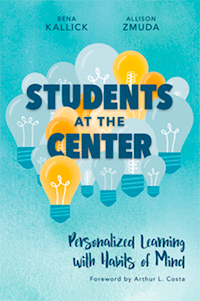 In Students at the Center: Personalized Learning With Habits of Mind, the authors craft a message that is persuasive, informative, and replete with resources that teachers can use as they begin to embrace personalized learning.
In Students at the Center: Personalized Learning With Habits of Mind, the authors craft a message that is persuasive, informative, and replete with resources that teachers can use as they begin to embrace personalized learning.
The book features seven chapters and a foreword by Art Costa, who developed the concept of Habits of Mind. Throughout the book, the authors feature useful tools, ideas, stories from teachers using personalized learning.
Early in the book, Kallick and Zmuda suggest that a key to student engagement is to “design experiences that help students get in touch with who they want to be” (p. 1). Designing those experiences requires teachers to think about four key attributes of personalized learning: Voice, Co-Creation, Social Construction, and Self-Discovery.
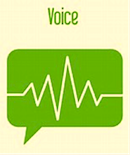 Voice provides students input into their learning experience by involving them in “the what” and “the why” of learning. When giving students voice, teachers can tap into relevant habits of minds include listening with understanding and empathy; questioning and problem-solving; and thinking and communicating with clarity and precision.
Voice provides students input into their learning experience by involving them in “the what” and “the why” of learning. When giving students voice, teachers can tap into relevant habits of minds include listening with understanding and empathy; questioning and problem-solving; and thinking and communicating with clarity and precision.
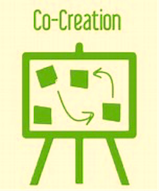 Co-Creation places the student side-by-side with the teacher as the challenge, problem, or idea is identified. Students can help with identifying and/or translating learning targets, crafting criteria for success, and outlining an action plan to accomplish the challenge or task. Relevant habits of mind include creating, imagining and innovating – and thinking flexibly.
Co-Creation places the student side-by-side with the teacher as the challenge, problem, or idea is identified. Students can help with identifying and/or translating learning targets, crafting criteria for success, and outlining an action plan to accomplish the challenge or task. Relevant habits of mind include creating, imagining and innovating – and thinking flexibly.
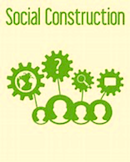 Social Construction involves students in building ideas “through relationships with others as they theorize and investigate in pursuit of common learning goals” (p. 4). In other words, social construction creates opportunities for students to learn by interacting in meaningful ways with each other. Habit of mind skills in play in this attribute involve taking responsible risks, gathering data, and thinking interdependently.
Social Construction involves students in building ideas “through relationships with others as they theorize and investigate in pursuit of common learning goals” (p. 4). In other words, social construction creates opportunities for students to learn by interacting in meaningful ways with each other. Habit of mind skills in play in this attribute involve taking responsible risks, gathering data, and thinking interdependently.
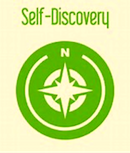 Self-Discovery encourages students to reflect about their role as a learner and “envision what might come next as well as what they might do next (p. 4).” According to Zmuda, self-discovery helps students identify “transfer goals” where they apply past knowledge to new situations using habits of mind like thinking about your own thinking (metacognition), and responding with wonderment and awe.
Self-Discovery encourages students to reflect about their role as a learner and “envision what might come next as well as what they might do next (p. 4).” According to Zmuda, self-discovery helps students identify “transfer goals” where they apply past knowledge to new situations using habits of mind like thinking about your own thinking (metacognition), and responding with wonderment and awe.
Some of you reading this blog are no doubt thinking, “How in the world can I successfully personalize learning every day for every one of my students?” Take heart! The authors suggest that personalized learning initially be offered as an “additional opportunity for learning” that can be used more widely as both the teacher and student become skillful at the particulars.
Getting Started
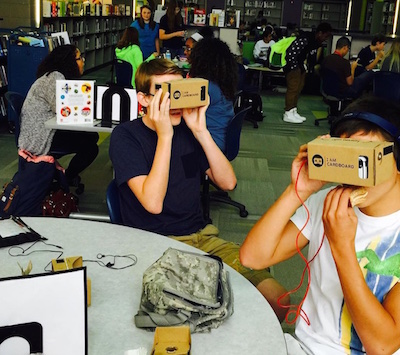
So, how does one get started? One idea is to have a genius hour, an approach used by teachers at a number of K-12 schools in Alabama. One striking schoolwide example is found at James Clemens High School in Madison City, where students enjoy a daily “Refuel Hour.” An hour a week (or in the case of JCHS, an hour a day) gives students time to pursue their own interests, seek additional help from a teacher, or simply meet and interact with friends.
Another personalized learning opportunity can be provided to students in the form of a culminating project. Students are involved over a longer period of time on a project that integrates a variety of standards and learning opportunities. The process usually culminates with a formal presentation or demonstration of each student’s work.
Ron Berger, leader of EL Education (formerly Expeditionary Learning), provides multiple examples of such projects in his book Leaders of Their Own Learning, and also at EL’s website and the companion Models of Excellence site, including:
✻ Slithering Snakes: Students became herpetologists and researched, created and narrated an ebook about snakes, including scientific drawing of their selected snake or reptile.
✻ Passage Portfolios: At certain junctures at EL schools, students research and present a major project as part of the requirement to advance to the next grade.
✻ Celebrations of Learning: Students work together on a common project and present their product to their parents or community.
Feedback is Key
Kallick and Zmuda stress that personalized learning without feedback could become an empty shell.
Embodied in the stamina, grace, and elegance of a ballerina—or the achievements of a writer, a shoemaker, an athlete, or any other successful professional—is the desire for craftsmanship, mastery, flawlessness, and economy of energy to produce excellent results.
Those who devote themselves to excellence pay attention to process and take time to refine their products. They review the high standards by which they abide, the models and visions they value, and the criteria they will use to confirm that their finished product matches or exceeds those criteria.
As teachers, we can’t guarantee that all our students will receive this kind of excellence in the wider world, but we can introduce all students to the process that’s integral to the positive struggle toward excellence—using feedback for growth. (p. 101)
Reflection is an important aspect of feedback as students are expected to reflect on their work from beginning to the end through self-assessment and feedback from others. Examples of prompts to spur this type of reflection include (pp. 116-117):
- How do you feel about the work you are starting?
- How do you envision your end results?
- How does the feedback you have been getting from your peers help you as you move forward with this project?
- How does this product compare with how you thought it would turn out?
- What insights have you learned that you will carry forward to the next project you do?
Today’s students face a connected, interdependent world that many of us couldn’t even imagine when we were students. They will be asked to solve problems that didn’t exist even a few years ago by taking what they know and have learned and applying it in different ways. Teachers can help students be prepared for an ambiguous future by inviting them to be co-creators of their learning.
I know many of you reading this blog are involved in personalizing learning for your students. Please share your ideas and insights in the comment section below!
Additional resources:
- Free ASCD webinar (archived): Students at the Center with Bena Kallick and Allison Zmuda.
- “Orchestrating the Move to Student-Driven Learning.” A Kallick & Zmuda article in the March 2017 issue of Educational Leadership, available to members.
- Their websites: Learning Personalized (Zmuda) and The Institute for Habits of Mind (Kallick).
- Carol Ann Tomlinson column: “Let’s Celebrate Personalization – But Not Too Fast.”
________
Cathy Gassenheimer is Executive Vice President of the Alabama Best Practices Center.

0 Comments on "How We Can Put Our Students at the Center of Learning"